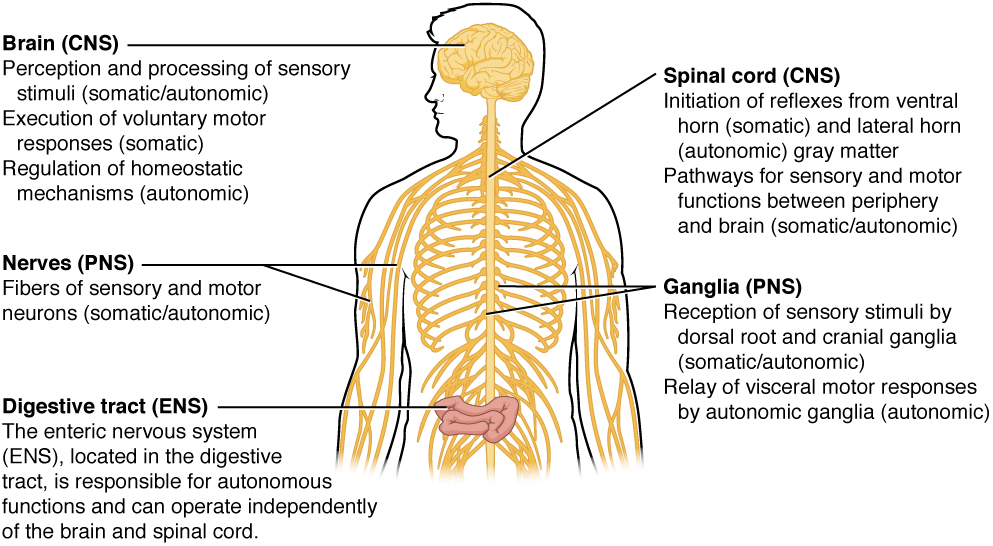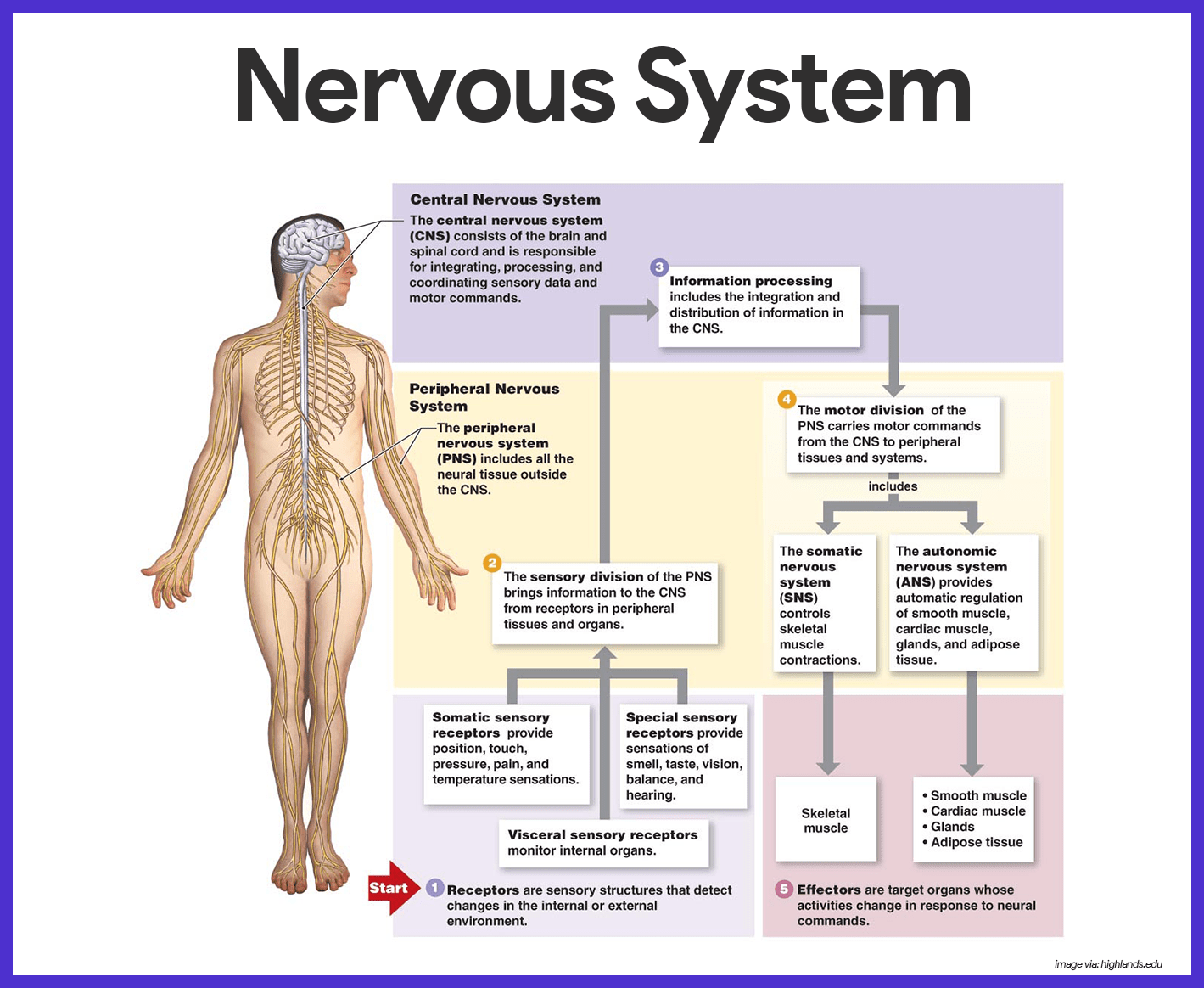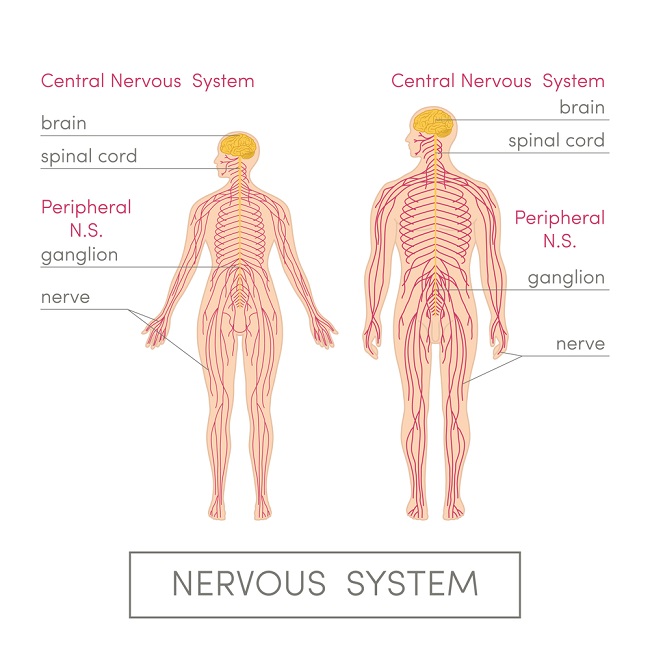These anatomical structures are made of inter-connected elements that create distributed and highly inter-connected circuits. Its main function is to conserve the bodys energy and to help you sleep or break down and absorb the food you eat.

Basic Structure And Function Of The Nervous System Anatomy And Physiology
The nervous system plays a role in nearly every aspect of our health and well-being.

. The sensory functions of the nervous system register the presence of a change from homeostasis or a particular event in the environment known as a stimulus. The central nervous system composed of the brain spinal cord and an extensive neuron network serves as the control center for all bodily functions. Forebrain components such as the.
The primary function of the central nervous system is integration and coordination. There are various cells which act as the major unit to. The spinal cord carries information from the brain to the rest of the body.
The PNS also regulates autonomic functions such as breathing heart rate and digesting the unconscious bodily behaviors. Fast facts on the central nervous system. The three broad functions of the CNS are to take in sensory information process information and send out motor signals.
The nervous system controls. Reception of general sensory information touch pressure temperature pain vibration Receiving and perceiving special sensations taste smell vision sounds Integration of sensory information from different parts of the body and processing them Response generation. The sympathetic is responsible for the fight or flight response that helps you quickly use your bodys energy in an emergency situationlike running away from danger.
It functions as the transmitter and receiver as well as the pathway for information flow and determines how the body responds to changes in its internal and external environment. Thus consuming approximately 30 percent of oxygen. The human brain is organized into the cerebral cortex brainstem subcortical structures and the cerebellum.
Receives messages from stimuli all over the body the brain interprets the message and the brain responds to the message and carries out an activity. Sensory input integration of data and motor output. Automatic activities such as breathing.
It is in these circuits where cognition. The 4 main functions of the nervous system are. The human brain is organized into the cerebral cortex brainstem subcortical structures and the cerebellum.
The nervous system has three main functions. The nervous system controls all our body movements. It is made up of two parts the central nervous system CNS and the peripheral nervous system PNS.
The CNS receives input from a variety of different sources and implements an appropriate response to the stimuli in a cohesive manner. The CNS receives sensory information from the nervous system and controls the bodys responses. Cells of the Central Nervous System.
The central nervous system CNS is part of a vertebrate nervous system which coordinates the sensory impulses and their relevant responses in the body. The central nervous systems responsibilities include receiving processing and responding to sensory information. The central nervous system consists of the brain and the spinal cord and the peripheral nervous system is made up of the nerves and neurons.
The brain is the most complex organ in the human body. The coordination centre such as the brain spinal cord or pancreas which receives and processes information from receptors around the body. Brain growth and development.
Describe the functions and structures of the central nervous system. Complete the pre-lab exercises and post lab exercises Here are some videos. The cerebral cortex the outermost part of the brain and the largest part by volume.
The Central Nervous System Learning Objectives. The CNS comprises the brain and spinal cord. What is Central Nervous System.
The nervous system subdivides into the central nervous system and the peripheral nervous system. Identify the structures of the brain and describe its gross anatomy Identify structures of the spinal cord Describe the structure and function of the meninges Be sure to read the lab and pay special attention to the bold terms and the figures. The central nervous system CNS is comprised of the brain and spinal cord.
It interprets information from the five senses in a body along. Introduction to Neuroanatomy The human brain is organized into the cerebral cortex brainstem subcortical structures and the cerebellum. The central nervous system is the brain and spinal cord while the peripheral nervous system consists of everything else.
Describe the functions and structures of the central nervous system Week 1. The main functions of the PNS are voluntary movements such as chewing food walking and facial expressions. And complex processes such as thinking reading remembering and feeling emotions.
These anatomical structures are made of inter-connected elements that create distributed and highly inter-connected circuits. Sensory input is when the body gathers information. Describe the functions and structures of the central nervous system.
List the major functions of the central nervous system. Sensations such as touch or hearing. Compare the roles of the nervous system and the endocrine system in coordinating and integrating body activities.
These anatomical structures are made of inter-connected elements that create distributed and highly inter-connected circuits. White and gray. The first major function of the nervous system is sensationreceiving information about the environment to gain input about what is happening outside the body or sometimes within the body.
The CNS can be roughly divided into gray and white matter. It guides everyday activities such as waking up. Central nervous system CNS anatomical division of the nervous system that includes the brain and spinal cord integration nervous system function that processes sensory perceptions and produce a response peripheral nervous system PNS anatomical division of the nervous system that extends from the brain and spinal cord to the rest of the body.
The PNS is thus especially important for humans to survive.

Nervous System Anatomy And Physiology Nurseslabs

Central Nervous System Definition Function Parts Biology Dictionary

0 Comments